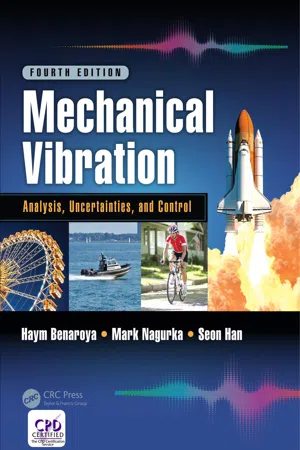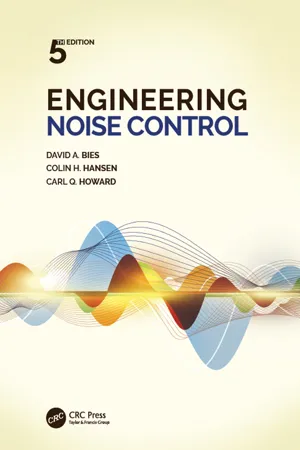D'alembert Wave Equation
The D'Alembert wave equation is a partial differential equation that describes the motion of a vibrating string. It is used in engineering and physics to model wave propagation in various media, such as strings, rods, and membranes. The equation helps in understanding the behavior of waves and is fundamental in the study of wave mechanics.
5 Key excerpts on "D'alembert Wave Equation"
- eBook - ePub
Designing Quiet Structures
A Sound Power Minimization Approach
- Gary H. Koopmann, John B. Fahnline(Authors)
- 1997(Publication Date)
- Academic Press(Publisher)
...The equation of state for a liquid medium is identical to that given in Equation (1.19), but is derived in a slightly different manner, as discussed by Pierce (1989, pp. 30–34). The wave equation Equations (1.14), (1.15), and (1.19) represent a system of three linear partial differential equations in three dependent variables, p′, ρ′, and v′. The physical quantity which is most easily measured for a sound wave is the pressure, and thus the equations will be reduced to a single partial differential equation for the acoustic pressure. We take the partial derivative with respect to time of the linearized equation of conservation of mass [ Equation (1.14) ] giving (1.20) and take ∇ · of the linearized equation of the conservation of momentum [ Equation (1.15) ] giving (1.21) Subtracting Equation (1.21) from Equation (1.20) yields (1.22) or, after substituting for ρ′ from the linearized equation of state [ Equation (1.19) ], (1.23) To simplify the notation, we drop the superscript so that ρ is the small fluctuating component of the pressure, and v is the acoustic velocity. Also, we take the ambient density of the fluid to be ρ, without the subscript 0. Equation (1.23) can then be written as (1.24) which is the desired result for the wave equation. As a simple example, consider an acoustic wave which does not depend on the y or z coordinate. The wave equation then reduces to (1.25) which has the general solution (1.26) In Equation (1.26), F and G are arbitrary functions representing plane waves traveling in the positive and negative x–directions, respectively. 1.2 The Helmholtz Equation for Time–Harmonic Vibrations In many of the design methods that we discuss in this book, the surface vibration and associated sound field occur at a constant frequency, a typical example of which is the hum of a transformer at 120 Hz. After an initial transient period, the pressure field generated by the vibration will reach steady state and fluctuate at the same frequency as the excitation...
- eBook - ePub
Mechanical Vibration
Analysis, Uncertainties, and Control, Fourth Edition
- Haym Benaroya, Mark Nagurka, Seon Han(Authors)
- 2017(Publication Date)
- CRC Press(Publisher)
...In this mathematical masterpiece, d’Alembert established his principle of mechanics: the forces which resist acceleration must be equal and opposite to the forces which produce the acceleration. The result is a condition of kinetic equilibrium. The principle has the advantage of reducing a problem in dynamics to one in statics. It also shows that Newton’s third law of motion applies to bodies free to move as well as to stationary bodies. With the notion of an inertial force, d’Alembert introduced his principle as a way of studying dynamic systems by applying laws of statics. D’Alembert’s contribution was crucial to the development by Lagrange of analytical mechanics. D’Alembert applied his principle to the equilibrium and motion of fluids. In 1744, he published his Traité de l ’ équilibre et du mouvement des fluides, which provided an approach to the study of fluid mechanics that was an alternative to the one published by Daniel Bernoulli. D’Alembert was the first to use partial differential equations in mathematical physics. In 1747 he published this idea in Réflexions sur la cause générale des vents on winds, for which he won the Prussian Academy prize. He applied the concept of partial differential equations to determine the dynamic response of deformable bodies. In the same year, d’Alembert published an article on the motion of vibrating strings that included the first use of the wave equation in physics. He used mathematically pleasing simplifications of certain boundary conditions that led him to results which were at odds with observation. In 1754, d’Alembert defined the derivative of a function as the limit of a quotient of increments. His ideas on limits led him to the test for convergence, known today as d’Alembert’s ratio test. D’Alembert wrote 1500 articles for the great French encyclopedia Encyclopédie, of which he was co‐editor with Denis Diderot...
- eBook - ePub
- David A. Bies, Colin H. Hansen, Carl Q. Howard(Authors)
- 2017(Publication Date)
- CRC Press(Publisher)
...B Wave Equation Derivation The derivation of the acoustical wave equation is based on three fundamental fluid dynamical equations: the continuity (or conservation of mass) equation, Euler’s equation (or the equation of motion) and the equation of state. Each of these equations are discussed separately in Sections B.1, B.2 and B.3. B.1 Conservation of Mass Consider an arbitrary volume, V, as shown in Figure B.1. FIGURE B.1 Arbitrary volume for illustrating conservation of mass. The total mass contained in this volume is ∫ ∫ ∫ V ρ tot dV. The law of conservation of mass states that the rate of mass leaving the volume, V, must equal the rate of change of mass in the volume. That is: ∫ ∫ S ρ tot U tot ⋅ n → d S = − d d t ∫ ∫ V ρ tot d V (B.1) where ρ tot is the total (mean plus time varying component) density of the fluid contained in the enclosed space of volume, V, at time, t, U tot is the total velocity of fluid in a direction outwards, normal to the enclosing surface, of area, S, at time, t, and n → is the unit vector normal to the surface, S, at location, d S. At this stage, it is convenient to transform the area integral on the left-hand side of Equation (B.2) to a volume integral by use of Gauss’ integral theorem, which is written. as: ∫ ∫ S ψ ⋅ n → d S = ∫ ∫ V ∫ ∇ ⋅ ψ d V (B.2) where ψ is an arbitrary vector and the operator, ∇, is the scalar divergence of the vector, ψ. Thus, in Cartesian coordinates: ∇ ⋅ ψ = ∂ ψ ∂ x + ∂ ψ ∂ y + ∂ ψ ∂ z (B.3) and Equation (B.1) becomes: ∫ ∫ V ∫ ∇ ⋅ (ρ tot U tot) d V = − d d t ∫ ∫ V ∫ ρ tot d V = − ∫ ∫ V ∫ ∂ ρ tot ∂ t d V (B.4) Rearranging. gives: ∫ ∫ V ∫ [ ∇ ⋅ (ρ tot U tot) + ∂ ρ tot ∂ t ] d V = 0 (B.5) or: ∇ ⋅ (ρ tot U tot) = − ∂ ρ tot ∂ t (B.6) Equation (B.6) is the continuity equation. B.2 Euler’s Equation In 1775 Euler derived his well-known equation of motion for a fluid, based on Newton’s first law of motion...
- eBook - ePub
- Dennis H. Goldstein(Author)
- 2017(Publication Date)
- CRC Press(Publisher)
...From our knowledge of differential equations, the additional term described by ∂E/∂t corresponds to damping or attenuation of a wave. Equation 22.9 can be considered the damped or attenuated wave equation. We proceed now with the solution of Equation 22.9. If the field is strictly monochromatic and of angular frequency ω so that E ≡ E(r,t) = E(r)exp(ia>t), then substituting this form into Equation 22.9 yields ∇ 2 E (r) = (− μεω 2) E (r) + (iωμσ) E (r), (22.10) which can be written as ∇ 2 E (r) = (− μω 2) [ ε − i (σ ω) ] E (r). (22.11) In this form, Equation 22.11 is identical to the wave equation except that now the dielectric. constant is complex, that is, ε = ε − i (σ ω), (22.12) where ε is the real dielectric constant. The correspondence with nonconducting media is readily seen if ε is defined in terms of a complex refractive index n ^ (we set μ = 1 since we are not dealing with magnetic materials), so that ε = n ^ 2. (22.13) We now express n ^ in terms of the refractive index and the absorption of the medium. To find the form of n ^, which describes both the refractive and absorbing behavior of a propagating field, we first consider the intensity I(z) of the field after it has propagated a distance z. We know that the intensity is attenuated after a distance z has been traveled, so the intensity can be described by I (z) = I 0 exp (− α z), (22.14) where α is the attenuation or absorption coefficient. We wish to relate α to κ, the absorption or attenuation index. We first note that n ^ is a dimensionless quantity, whereas we can see from Equation 22.14 that α has the dimension of inverse length. We can express az as a dimensionless parameter by assuming that after a distance equal to a wavelength λ, the intensity has been reduced to I (λ) = I 0 exp (− 4 πκ). (22.15) Equating the arguments of the exponents in Equations 22.14 and 22.15, we have α= (4 π λ) κ = 2 k κ, (22.16) where k = 2π/λ is the wave number. Equation 22.14 can then be written...
- eBook - ePub
- Thomas L. Szabo(Author)
- 2013(Publication Date)
- Academic Press(Publisher)
...A related useful trick is multiplying the last equation by c : (3.65B) Equations 3.64 and 3.65B can be written out as matrices and vectors well suited for MATLAB: (3.66) (3.67) For waves along z and no force, T can be eliminated by taking the time derivatives of the first set of equations and the spatial derivatives for the second set. Examples for deriving wave equations follow: (3.68A) (3.68B) (3.68C) where this wave equation is for longitudinal waves along z with a speed of sound ; (3.69A) (3.69B) (3.69C) where this wave equation is for x -polarized z -propagating shear waves with a speed of sound. 3.5 Conclusion In this chapter, wave equations describe three basic wave shapes. When waves strike a boundary, they are transmitted and reflected. For the one-dimensional case, solutions consist of positive- and negative-going waves. Through the application of ABCD matrices, solutions for complicated cases consisting of several layers can be constructed from cascaded matrices rather than by re-deriving the equations needed to satisfy boundary conditions at each interface. This approach will be used extensively in developing a transducer model in Chapter 5 and Appendix C. Matrix methodology has been extended to oblique waves at an interface between different media. Even though tissues are most often represented as fluid media, they are, in reality, elastic. An important case is the heart, which has muscular fibers running in preferential directions (to be described in Chapter 9). In addition, elastic waves are necessary to describe transducer arrays and piezoelectric materials (to be discussed in Chapter 5 and Chapter 6). An extra level of complexity is introduced by elasticity; namely, the existence of shear and other forms of waves created from both boundary conditions and geometry. Reflection and mode conversions among different elastic modes can be handled in a direct manner with the equivalent approach introduced by A. A. Oliner...




